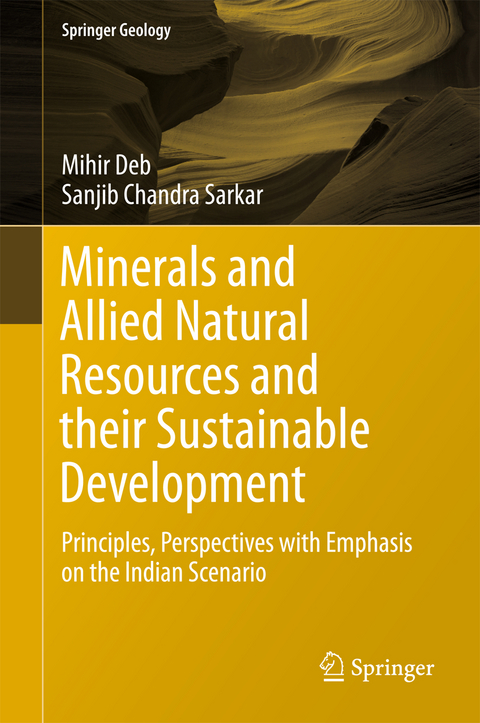
Minerals and Allied Natural Resources and their Sustainable Development
Springer Verlag, Singapore
978-981-10-4563-9 (ISBN)
Mihir Deb’s research interests for close to five decades have centered on non-renewable natural resources, their environment of formation and sustainability of extraction. He has published over 100 scientific articles in peer-reviewed national and international journals and has edited three scientific volumes (published by Narosa Publishing House). With an undergraduate degree from Presidency College, Calcutta and Master’s and Ph.D. from Jadavpur University in Ore Geology, he joined as faculty in the University of Delhi in 1970 and then pursued post-doctoral research in the City University of New York. He was an Alexander von Humboldt fellow at the University of Göttingen, Germany and at the University of Leicester, U.K. He served as the Head, Department of Geology (2000-2003) and as Director of the School of Environmental Studies (2004-2009) at Delhi University where he initiated an innovative postgraduate course in Environmental Studies with a holistic approach. He has guided a dozen students for Ph.D. in these two disciplines and conducted several basic and applied scientific projects and international collaborative research. His geological and environmental field work have made him travel extensively in North and South Americas, Europe, Mongolia, Vietnam, Indonesia, and parts of Australia and Africa. He also served as Director of the University Science Instrumentation Centre from 2000-2006. He superannuated from Delhi University in 2010 and continued his research and teaching as INSA senior scientist till August, 2014. He joined the newly established Nalanda University at Rajgir, Bihar in September, 2014 and served as a Visiting Professor and the first Dean of the School of Ecology & Environment Studies for a full academic year and initiated an interdisciplinary post-graduate course. Professor Deb worked in different capacities in several national bodies. These included: Member, State level Environmental Expert Appraisal Committee, NCT of Delhi; Member, Geoscience Advisory Committee of the Ministry of Mines, Govt. of India; Member, Apex Exploration Research Advisory Committee, Department of Atomic Energy, Govt. of India; Member, Working Group on Mineral exploration and Development, Planning Commission (2006); Member, Academic Council of TERI University; Member, Council, Geological, Mining, Metallurgical Society of India. In the International sphere, Mihir Deb served as the Indian representative to Communities and Small scale Mining (CASM), a World Bank initiative; Asian representative in IUGS-GEM (Geoscience for Environmental Management, an ICSU commission) and Member, UNECE Ad Hoc Group of Experts on Harmonization of Fossil Energy and Mineral Resources Terminology. Mihir Deb was awarded N.N. Chatterjee medal of the Asiatic Society, Calcutta in 1976, the National Mineral Award (Govt. of India) in 1996 and a gold medal of the Indian Geophysical Union in 2013. He is a Fellow of the Indian National Science Academy since 2002 and a Fellow of the Society of Economic Geologists, U.S.A., since 2004. He is also a Life Fellow of the Geological Society of India and the Geological, Mining and Metallurgical Society of India. Sanjib Chandra Sarkar has taught and conducted research in the Department of Geological Sciences, Jadavpur University, Calcutta, India, for more than four decades. He has published a large number (+60) of research papers in national and international journals, particularly in his area of interest, Precambrian geology and Metallogeny. He has authored two books (One published by Jadavpur University Press, 1984 and the other, co-authored by A. Gupta, by Cambridge University Press, 2012) and an international conference Proceedings Volume (published by Oxford-IBH and Balkema, 1992). His present interest centers on India’s sustainable development in the context of its natural resources. Sanjib Sarkar was an undergraduate student in Presidency College and did his Master’s degree from Jadavpur University, Calcutta. Then he proceeded to Moscow State University (former USSR) for his Ph.D. degree in Geology & Mineralogy under the supervision of the eminent Academician, V.I. Smirnov. He also participated in a course in Experimental Sulfide Mineralogy at Lehigh University, Pennsylvania, U.S.A. He was the Head of the Department at Jadavpur University between 1981-84 and was also the Coordinator of the UGC Center of Advanced Study in Economic Geology, Structural Geology and Petrology from 1984 to 1997. He guided 10 Ph.D. candidates during his tenure. He was the regional councillor for Asia in the International Association on Genesis of Ore deposits (1984-89). He also co-chaired the Working Group on ‘Ore and Metamorphism’ (1992-99) and served as a Leader of an International Geological Correlation Programme (IGCP-247) on Precambrian Tectonics and Metallogeny (1987-92). Professor Sarkar who also served as a member of the International Commission on‘Tectonics and Metallization’ has visited many mineral deposits around the world. He is a Fellow of the Society of Economic Geologist (SEG), USA; Fellow, West Bengal Academy of Sciences & Technology, Life Fellow of the Geological Society of India and the Geological, Mining, Metallurgical Society of India. Professor Sarkar was awarded Prof. N.N. Chatterjee medal for important contribution to Economic Geology by the Asiatic Society, Calcutta in 1969. He was also awarded the Geological Survey of India Sesquicentennial Commemorative Gold medal of the Asiatic Society in 2012 for “significant contribution in the field of Earth Science”. He was a DST National Lecturer during 1997-98.
Part I. Minerals Resources.- Part II. Allied Natural Resources.- Appendices.- Part III. Sustainable Development of India's Mineral and Allied Resources.
| Erscheinungsdatum | 18.07.2017 |
|---|---|
| Reihe/Serie | Springer Geology |
| Zusatzinfo | 44 Illustrations, color; 190 Illustrations, black and white; XXVI, 569 p. 234 illus., 44 illus. in color. |
| Verlagsort | Singapore |
| Sprache | englisch |
| Maße | 155 x 235 mm |
| Themenwelt | Naturwissenschaften ► Biologie ► Ökologie / Naturschutz |
| Naturwissenschaften ► Geowissenschaften ► Geologie | |
| Naturwissenschaften ► Geowissenschaften ► Mineralogie / Paläontologie | |
| Technik ► Maschinenbau | |
| ISBN-10 | 981-10-4563-1 / 9811045631 |
| ISBN-13 | 978-981-10-4563-9 / 9789811045639 |
| Zustand | Neuware |
| Haben Sie eine Frage zum Produkt? |
aus dem Bereich


